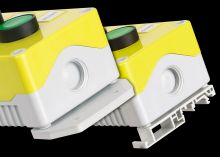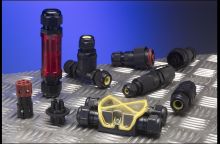
Making the Right Connections for Rainwater Harvesting
Rainwater harvesting is an efficient method for both businesses and private households to retain an independent water supply for use when restrictions are levied. With hosepipe bans in place across many parts of the country, despite heavy rainfall, now more than ever harvesting systems are proving their worth. An efficient and reliable harvesting system can save businesses and private households a considerable amount of money on their yearly water bill; to achieve this OEMs and installers need to source tough electrical components that aren’t phased by a little rain.
Terry Spriggs from Hylec-APL, a specialist supplier of electrical components, offers advice on an ideal range of weatherproof connectors, enclosures and control stations.
Simply put, rainwater harvesting is the accumulation and reuse of rainwater through human intervention before it reaches the Aquifer, or water table. It is now common for many industrial plants and businesses to harvest and treat rainwater to reduce their reliance on mains supplied water; many households across the UK also have their own underground tanks which supply water suitable for running washing machines, gardening or for flushing the toilet.
Using treated rainwater for cleaning operations can reduce the build up of lime scale and the installation and running costs quickly pay for themselves in areas where mains water supply is metered, meaning it is environmentally and economically efficient. In urban areas particularly, rainwater harvesting offers distinct advantages on both the micro-scale and the macro-scale; individuals and businesses secure their own private water source during times of restriction, while the pressure on storm water run-off systems is relieved during times of particularly torrential rain.
Urban harvesting systems that involve underground tanks use a very simple process of drain networks to collect rainwater runoff from surrounding areas and direct it to the tank; from here a pump is used to deliver the water as required. Depending on how the water will be used, different filtration systems will be installed to process the water and remove detritus and contaminants. Tanks will also often be fitted with ‘float-switches’ which monitor the water level and automatically switch on a feed from the mains supply when it gets too low; this prevents the pump from damaging itself by running dry.
Due to the nature of the applications it goes without saying that any electrical connections need to be well protected from water ingress and control stations with power on/off switches will often be exposed to varying weather conditions. With the profitability of a system resting on its low maintenance requirements it is important for installers to specify the right components.
Rather than sourcing different components from different suppliers, many OEMs and installers within the rainwater harvesting industry are looking to use kitted packages from electrical component suppliers such as Hylec-APL. Each product specifically designed to provide quick and simple installation whilst providing the correct level of protection from water ingress and adverse weather conditions.
Pre-assembled control stations are available from many electrical suppliers which allow OEMs to include power isolation and emergency stop features without the hassle of specifying components for unique units. Often positioned by the harvesting system’s outlet tap and exposed to rainfall itself, easy access door enclosures will regularly be used to house the control station to provide added ingress protection.
Hylec-APL offers a range of registered design control stations and door enclosures suitable for this type of application. The control stations are available with a significant selection of push button and selector switch types from the latest EN418 emergency stop units, with twist or key operated release options, to large dome top palm/foot operated switch stations. The control stations also benefit from a unique snap on bracket for faster wall/panel mounting.
Positioned underground, or in direct contact with rain and flowing water, it is essential that all electrical connections are securely protected from water ingress. Rather than traditional industrial connectors, which require specialised tooling and bulky housing, Hylec-APL recommends the Tee Family range of connectors.
Consisting of in-line connectors, junction boxes and plugs, the Tee Family offers IP68 security in a range of sizes and pole connections. The innovative range uses dome topped cable glands to seal the terminal block within a discrete, polyamide casing. Some products within the range are also available with a transparent body which allows for easy inspection without compromising ingress protection.
3P Technik, the only Trade Only supplier of rainwater harvesting equipment to the UK and Ireland, uses a T-Shaped, 5 pole TeeTube to bring the power feed to the water pump and then spur off to the float switch. Having used enclosures to make the connection in the past they swapped to the TeeTube as it reduced installation time and created a more aesthetic finish.
With reliability and easy integration being the key for designing and installing profitably rainwater harvesting systems, we would always recommend sourcing electrical components from a single, knowledgeable supplier. Speak to your supplier’s sales team to see how they can help you to develop a complete kitted package which is ideally suited to your systems.
Latest News
-
02/01/2025
BCL Enclosures joins Hylec -
27/09/2024
Hylec Showing at EDS 2024 We are exhibiting at EDS... -
30/01/2024
Exciting New Appointments for Hylec Hylec Kickstarts... -
11/01/2024
Hylec Go Kart Grand Prix The line-up for the first... -
01/12/2023
Hylec Closing dates for Christmas Hylec-APL will be closed from... -
01/02/2023
Hylec introduces new, improved Debox SL Hylec introduces the...
01933 234400




